All about baby bike seats
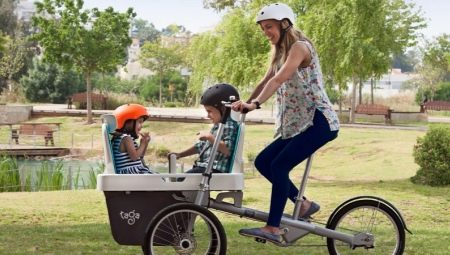
Bicycle seats are a useful invention and guarantee the safe transportation of your baby on a bicycle. Their high popularity and demand are due to their wide consumer availability, ease of installation and ease of use.
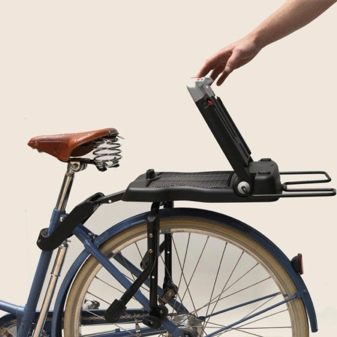
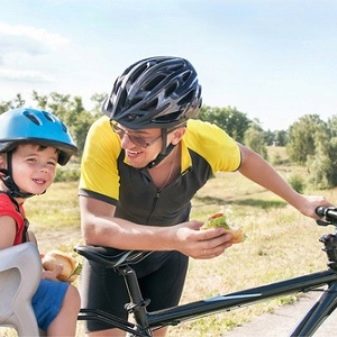
Why do you need a child seat?
Bicycle chairs for children were developed relatively recently - no more than 20 years ago. The innovation has confidently stepped into the bicycle accessories market and has been appreciated by active parents. Compared to previous methods of transporting children on large bicycles, such as riding on a frame or on a rear rack, bicycle seats were presented to consumers as a model of comfort and safety.
The old ways of transporting children were quite risky and often ended in injuries, in addition, the child was forced to sit almost motionless, so as not to accidentally shift the center of gravity to the side and not upset the balance.
Staying in this position throughout the trip was very tiring, because of which the joint travel of parents and children was reduced to nothing and happened only in case of emergency.

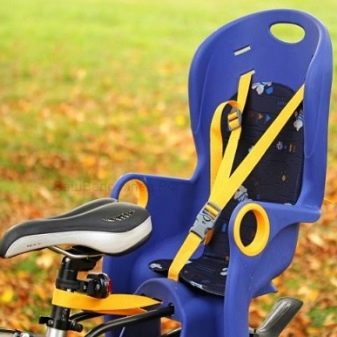
In addition, the metal frame and trunk were very uncomfortable for placing the baby, and even tying the pillows on them and installing an additional seat on the frame did not add to the comfort of the trip. Moreover, during such transportation, amortization was completely absent, as a result of which the baby felt every bump and pothole on himself.
The advent of bicycle seats has completely solved the problem of transporting children on adult bicycles. and contributed to the development of family cycling tourism and joint cycling trips between parent and baby. Now adults do not need to worry about the fact that the child catches every hole and can slip to the ground at any moment. Modern armchairs have side protection, comfortable seat and secure attachments, which together provides comfort and complete protection of the little passenger.
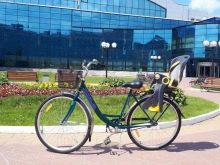


Varieties
Child bike seats are classified based on location, attachment and size. The determining one is the location of the chair, since the convenience of the baby and the psychological comfort of the parent depend on it. According to this criterion, there are two types of bicycle seats - front and rear.

Front
In this case the bike seat is located in front of the rider, between the seat and the handlebars of the bike. There is no unequivocal opinion regarding the convenience of such an arrangement, the opinions of the parents are divided approximately equally. Some argue that the front seat is much more comfortable than the rear one and allows you to visually control the child throughout the trip.
Others, on the other hand, believe that such an arrangement impairs the bike's maneuverability, does not allow pedaling freely, distracts the adult's attention and impairs the view. In addition, if the bike frame is too short, there is always a risk that the child may accidentally hit the parent's head on the chin. This, in turn, can lead to loss of balance and the fall of the vehicle.
Another argument against the opponents of front cycling seats is the fact that such models are usually much smaller than the rear ones, which is why they do not provide maximum protection for the child's head in case of force majeure. In addition, in most cases, transport on the front seats, only small children are allowed, the weight of which does not exceed 15 kg.
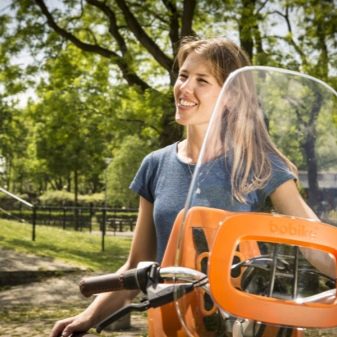
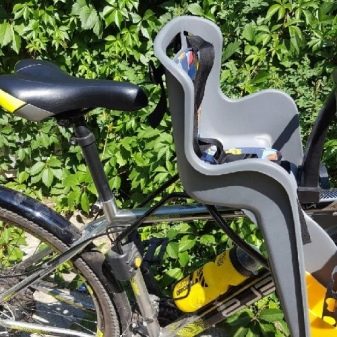
Parents do not like the fact that the baby is completely unprotected from the headwind, which makes it necessary to dress him in windproof clothes. Moreover, in the front seats, the backrest is static and cannot be adjusted, therefore, if the child falls asleep, he will have to ride while sitting.
Adherents of the front seats claim that this method of transportation, on the contrary, is very convenient. - it allows the child to contemplate the surrounding space at a wide viewing angle and be constantly supervised. In addition, in the case of front placement, the rear rack remains always free and allows you to place luggage on it. There is also a lower load on the child's spine than when it is located above the rear wheel.
Having weighed all the pros and cons, we can conclude that the front seats are good for short walks in calm weather with a baby up to 3 years of age.
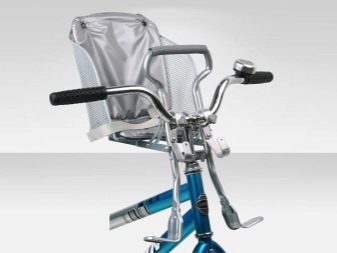
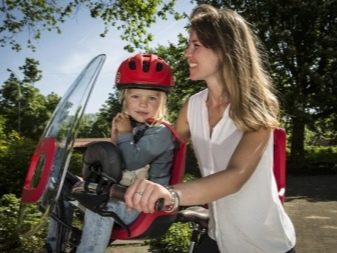
Rear
Most cyclists consider this type of bicycle seat a more optimal choice and actively use them. In this case, the child is located behind the back of an adult and is reliably protected from the wind. The advantages of the rear options include more reliable protection for the baby, which is provided by the reinforced structure of the seats. They are much wider and higher than the front counterparts and are often produced with a reclining back, which allows the child to fully rest during the trip. In addition to adjusting the backrest tilt, most models provide adjustable footrest function that allows you to change the position of the baby's body during long trips.
Besides, the child in the back does not interfere with the operation of the bike, unlike the toddler sitting in front of the parent. Another advantage of rear seats is the fact that they can be installed on folding bicycles that have a folding mechanism on the base frame and do not allow the front seat to be installed on it.
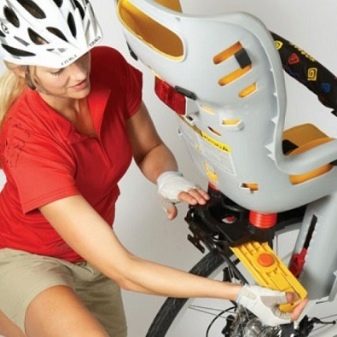
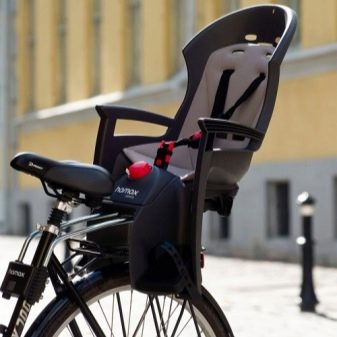
Among the undoubted advantages, it can be noted that most of the models are designed for a weight load of up to 25 kg, which allows even first-graders to be transported in them.
The disadvantages of rear seats include the child's narrow viewing angle, which is why he has to ride with his head constantly turned to the side, as well as the low shock absorption of models attached to the trunk, which is especially true for road bikes. Among the minuses, one can also note loss of visual contact with the baby behind the parent, however, installing rear-view mirrors solves this problem. Thus, rear bike seats are more versatile and allow for long trips on bicycles of any design with children under 6 years old.
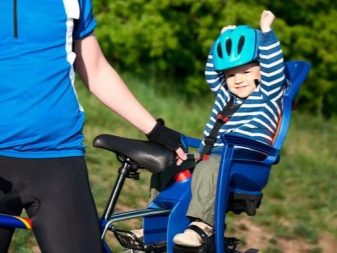
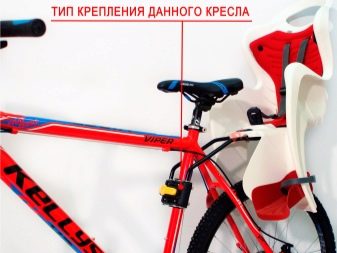
Mounting options
In total, there are 4 options for attaching bike seats to a bicycle: on the steering column, on the frame, on the seat tube and on the trunk.
On the steering column
This type of attachment involves the installation of seats for very young passengers, whose weight does not exceed 10-12 kg. This is due to the fact that the transportation of older children on the steering wheel makes it much more difficult to control the vehicle, creates a large weight load on the front fork or shock absorber and makes it difficult to see.

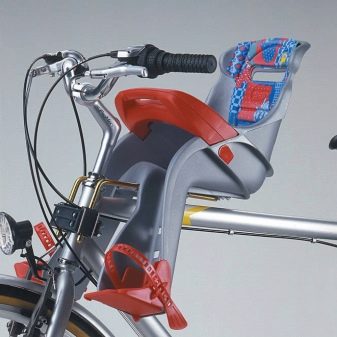
On the frame
When placing a child in front, the seat is attached to the supporting frame of the bicycle. In most cases, these designs are used on bicycles with rear shock absorbers. The carrying capacity of frame samples usually does not exceed 15 kg, footrests are often absent. Such models have a number of installation restrictions and cannot be fixed on frames with gearshift and brake cables running along the upper crossbar.
What's more, they cannot be fitted to ramp, drop and short frames, or most folding bicycles.
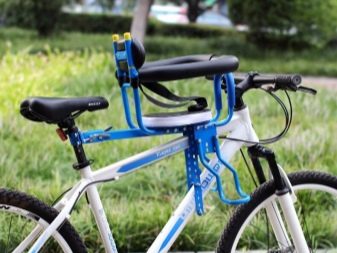
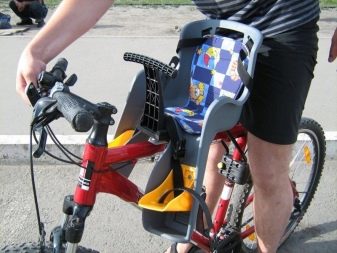
On the trunk
This type of fastening is the most optimal option when transporting large children, since chairs with such fasteners have a fairly large carrying capacity. The trunk can easily support a child weighing up to 25 kg, which the steering wheel and frame cannot afford. In addition, seats with this type of fastening are suitable for almost all models of bicycles with a trunk, which compares favorably with frame models, which cannot be installed on every bike.
Another undoubted advantage of such fasteners is the fact that it is possible to install wide seats with volumetric footrests on the luggage racks, which in no way affect the vehicle's handling and do not disturb its balance. The disadvantages of this type of attachment include low depreciation, which, however, is easily solved by purchasing a bicycle seat with built-in springs.
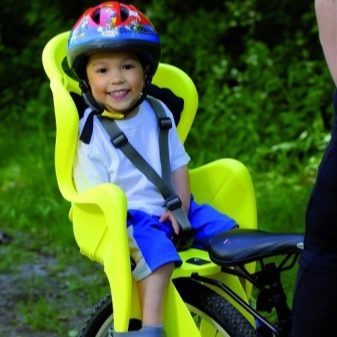
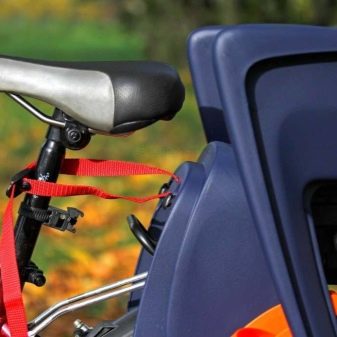
Seat tube
Seatpost-mounted bike seats are a very comfortable option and are the most preferred choice by parents. The advantages of such samples include high carrying capacity and versatility, allowing them to be used on almost any bike.
The exception is non-standard exclusive vehicles in which the seat tube and post have a rectangular or square section, or too small (large) diameter. Among the advantages of such models is noted large carrying capacity, allowing you to transport children aged 6 and even 7 years, weighing up to 25 kg.
Another advantage of these chairs is ease of installation... To do this, a special lock is installed on the seat tube, into which steel "mustache-fasteners" are inserted and latched.
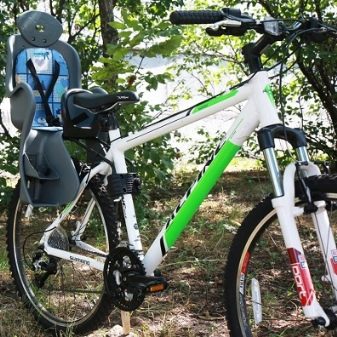
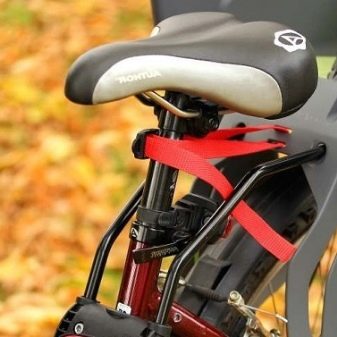
In the future, the bike seat can be easily removed, leaving the lock under the saddle on the pin, and, if necessary, install it back with one movement.
Such a mount is indispensable for long journeys, when both parents use bicycles. In such cases, it is recommended to purchase and install a separate lock for each vehicle. This will allow parents to carry the baby one at a time, moving the seat from one bike to another.
Among the disadvantages of seats with seatpost fasteners can be noted the inability of parents to constantly keep children in sight and a small angle of view for the baby. In addition, these models are not recommended for use on bicycles with a rear shock absorber. Another significant drawback of seats that are attached to the seatpost is the wobbling effect that occurs due to a shift in the center of gravity and an incorrect distribution of weight relative to the base of the bike.

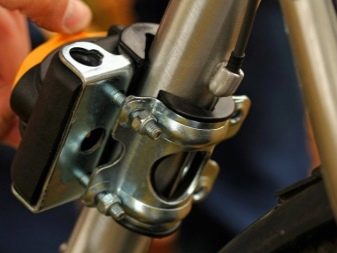
We take into account the age of the child
When buying a bicycle seat, the age and weight of the child must be taken into account. Despite the fact that there are quite miniature models on the market designed to carry very young passengers aged 6 months, pediatricians and sports medicine physicians do not recommend transporting such small children. According to most experts, joint cycling can only be started when the child reaches one year of age.
Otherwise, there is a risk of overloading the fragile spine, which can cause negative consequences in the future. However, in addition to age, it is necessary to assess the level of individual development of the baby. So, some children begin to sit at the age of 6 months and by 9-11 months are able to be in a sitting position for a long time, while others by this age have just learned to sit on their own and are not yet ready to withstand a motionless stay in a sitting position for a long trip.
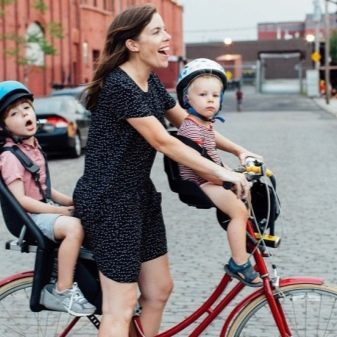

The most optimal age for starting joint trips is considered to be the age of one and a half years. By this time, most children show an increased interest in what is happening around them, and riding a bike causes them positive emotions. Many parents take their children by bike to kindergarten or to the nearest park to the place of walking. If the journey to the destination is too long, toys are hung in the chair so that the child does not get bored.
When using a cycling seat, be careful so that the child's weight does not exceed the maximum carrying capacity of the model and, if necessary, immediately replace the old seat with a new one. It is recommended to purchase your own version for each weight, without practicing “growth” purchases. Most models have a maximum load capacity of 22-25 kg. Children over 7 years old should purchase a separate bike.
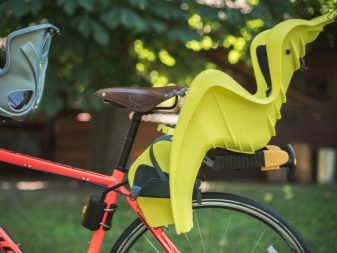
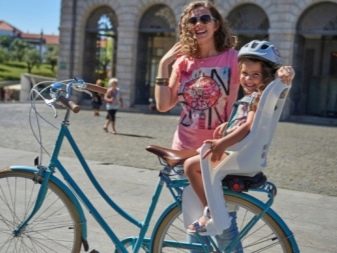
Famous brands and models, their rating
The modern bicycle accessories market offers a huge selection of child seats from different manufacturers. Below are the popular models, reviews of which are most often found on the Internet.
Hamax AS
One of the leaders in the production of bicycle seats is given a Norwegian firm that has been in business since 1958, producing the first chair in 1981. As an example, consider the model Hamax smiley worth 7490 rubles. The model is equipped with soft, but at the same time very durable 3-point harness and has an ergonomic backrest that allows the child to lean back in a helmet.
The belt buckles are made using a special technology that prevents self-unfastening. The product is attached to an oval or round seat tube with a diameter of 28 to 40 mm and is set to the desired height. The seat is suitable for mountain bikes, sports bicycles and high-speed bicycles, designed for babies over 9 months old and can withstand weight up to 22 kg. The model itself is quite light and weighs only 4.35 kg.
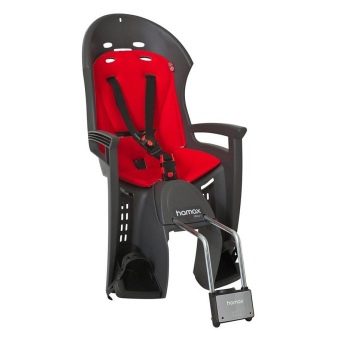
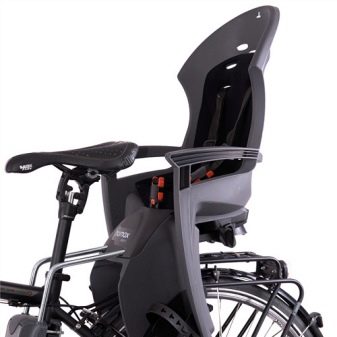
Bellelli
The Italian company has been known on the world market since 1994 and is engaged in the production of bicycle seats and accessories. For example, consider Pepe Clamp model worth 3873 rubles.The seat is designed to be installed on the trunk of a bicycle, is designed for children weighing up to 22 kg and is equipped with special shields that prevent legs from getting into the spokes.
The straps are padded and the back is perforated to help natural ventilation. The model has a European TUV series quality certificate.
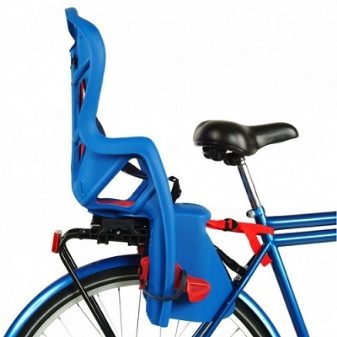
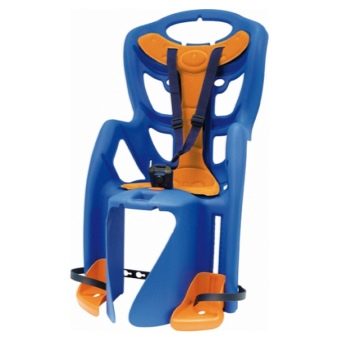
"Russian toys"
Considering well-known brands, one cannot fail to mention the Russian enterprise that developed and launched into production the unique Velogruz model. The unusual feature of this chair is its high load capacity, reaching 35 kg. The model is fixed on the frame and is equipped with a windshield that protects the child from headwinds and dust.
The product is designed for children from one year old and is equipped with a child's steering wheel, which makes the baby's trip interesting and memorable. The seat is designed in such a way that it does not shift the center of gravity of the bike and does not interfere with control. Such a product costs 4300 rubles.
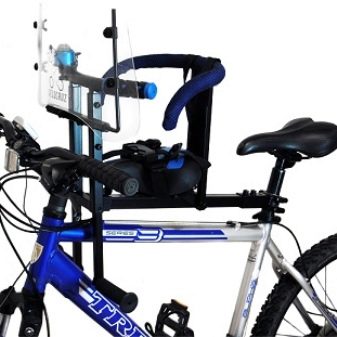
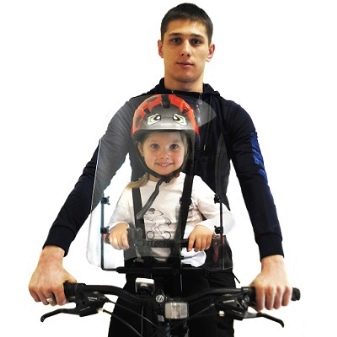
"Marusya"
Another interesting model of Russian production. The bike seat is designed for children weighing up to 30-35 kg and has a slightly unusual configuration... Its design consists of a saddle, mounting bracket, T-shaped footrest and a removable static handle with soft grips. The attachment is made to the seatpost of the bike, but the child is not positioned behind the parent, but in front.
It should be noted that the center of gravity with this arrangement of the baby does not shift to the front wheel, but is in the middle of the bike. The seat is patented, certified and meets all safety requirements. The cost of the model is 2200 rubles.
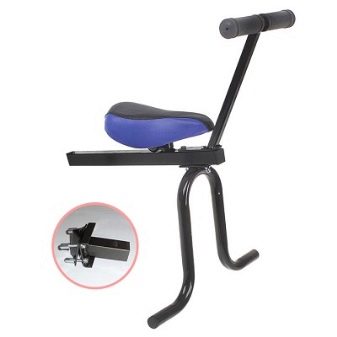
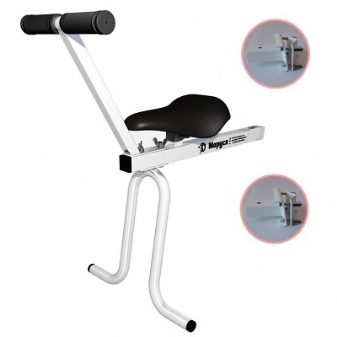
Stels
The company is well known to domestic bicycle lovers, as it produces good quality competitive products... The most budgetary model of the company is the model JL-190, which is a folding bicycle chair-chair. The product is installed on the trunk of a bicycle and is designed for toddlers weighing up to 15 kg. The model is equipped with small footrests, has seat belts and costs only 900 rubles.


How to choose?
There are several important points to consider when choosing a child bike seat.
- Make sure that the model you like is compatible with the bike. This is especially true for seats with seatpost and frame mount. So, if there are cables on the frame, you will have to refuse to buy a front seat, and if you have a square section of the seat tube, you need to buy an option with a mount on the trunk or frame.
- The next important condition is the presence of 3 or 5-point seat belts with soft pads, which must be adjusted in length and have a reliable lock.
- You also need to pay attention to the presence of side protection, which ideally should cover the child from the top of the backrest to the footrest. To prevent injury to the baby's hands in the event of a bicycle fall, it is better to purchase models with armrests.
- When buying a bicycle seat for a very young passenger choose a model with an adjustable backrest. This will make it possible to change the position of the baby's body during the trip and will allow him to put him to sleep on the way.
- Pay attention to the back of the chair. Its upper part should be designed in such a way that a child wearing a helmet can easily lean back and sit comfortably.
- It is advisable to pay attention to the availability of spare parts for the selected model in the free sale. Otherwise, minor damage or failure of even the most insignificant element will turn the chair into an unusable thing.
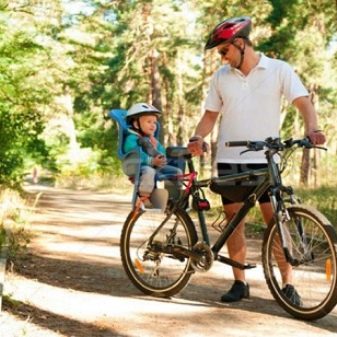
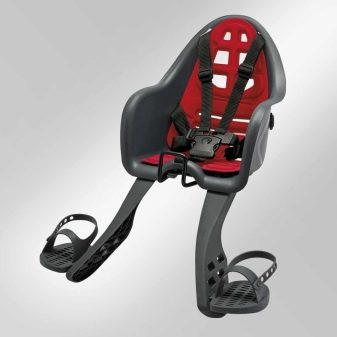
Also, when choosing a bicycle seat, you need to take into account that all models differ from each other in the degree of protection.
- To the third category includes shallow seats that hide only the baby's hip joint.The footrests of such models are represented by sliding bars, the backrest barely reaches the upper third of the back, and the body is fixed at the waist level. When the bike falls, the child's legs and arms suffer, and when passing close to the bushes, the entire side of the body is scratched. These points must be taken into account and such models should be used exclusively for short, unhurried trips along the flat and wide alleys of the park.
- Second category protection is represented by models with a deeper seat and full-height leg protection using plastic bumpers. The back of such chairs is also not too high, the child is fastened with a waist belt, the legs are securely fixed to the footrests. When falling, the arm suffers, while the legs remain unharmed.
- Models related to the first category of protection, have a high back, with a head hiding the child, and a deep seat. The fastening is carried out crosswise from the shoulders to the waist, and the legs are securely fixed on the footrests. In a fall, neither arms nor legs are affected, and the only thing that can happen is minor bruises on the hip and shoulder.
The only drawback of such chairs is the child's completely closed side view, and the parent's back does not allow looking forward.
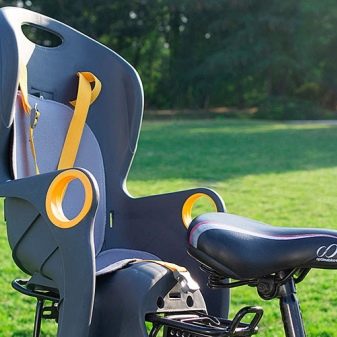
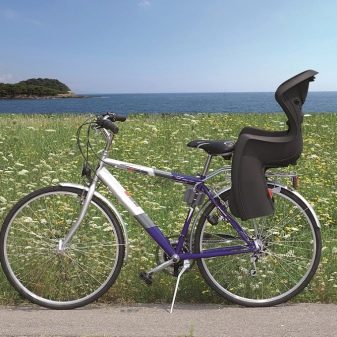
Accessories
When buying a bicycle seat for a child, you need to take care of the availability of additional accessories that will make the trip more pleasant and comfortable. The complete set of the chair can be supplemented with a sun screen or a visor, a warm blanket, a raincoat, a reflective reflector or an LED indicator. Also, it will not hurt to purchase an adapter and additional brackets that allow you to install the chair on a non-standard bike.
If the seat of the chair seems harsh, then you can purchase a soft liner made of dirt-repellent breathable material and has a beautiful color.
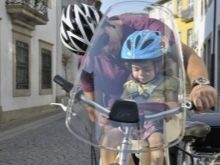
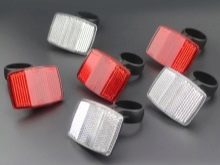

Advice
When using a child bicycle seat, you should follow the safety rules and heed the advice of specialists.
- You can't sit a child in a chair earlier, than he will be one year old.
- Attach luggage to the seat or placing it in a chair with a baby is strictly prohibited.
- When the bike is moving the child's feet should stand with their full feet on the footrest and, to avoid getting into the wheel, be fixed with straps.
- Before every departure you need to check the integrity of the bike seat and the reliability of its attachment to the bike.
- Before you put the baby in the chair, it is necessary to put on a protective helmet and make sure that his body does not touch the wheels, handlebars, parental saddle, chain and cables.
- Dress your child before the trip should be somewhat warmer than an adult is dressed. This is due to the passive state of the baby during the trip and the headwind, which can cause hypothermia in a lightly dressed child.
Compliance with these simple rules will help keep your baby healthy and make cycling with parents comfortable and safe.



For information on how to choose a child bike seat, see the next video.








